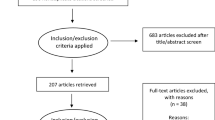Abstract
Objective: To evaluate the safety and pharmacokinetics of tazarotene cream 0.1% under standard (face only) or exaggerated (15% body surface area, including the face) application conditions after a single dose and after repeat topical applications once daily to patients with acne vulgaris or photodamaged skin.
Methods: Two separate, randomised, single-centre, nonblinded, parallel-group pharmacokinetic studies were conducted. In one study, tazarotene cream 0.1% was applied either to the face of eight female patients with moderate acne or to 15% body surface area of ten female patients with severe acne. In the other study, tazarotene cream 0.1% was applied either to the face (six females, two males) or to 15% body surface area (8 females, 8 males) of patients with photodamaged skin. In both studies, tazarotene cream 0.1% was applied once daily (except on days 1 and 2) for 30 days. Blood was drawn for measurement of plasma concentrations of tazarotenic acid at defined time intervals after application of the cream. Plasma tazarotenic acid concentrations were determined by a validated gas chromatography-tandem mass spectrometry method with a lower limit of quantification of 0.005 μg/L.
Results: At exaggerated application rates in patients with acne vulgaris, the maximum average peak concentration (Cmax) and 24-hour area under the concentration-time curve (AUC) values of tazarotenic acid were (mean ± SD) 1.20 ± 0.41 μg/L (n = 10) and 17.0 ± 6.1 μg · h/L (n = 10), respectively, and occurred on day 15. The single highest Cmax was 1.91 μg/L. At standard application rates in patients with acne vulgaris, the maximum average Cmax and AUC values of tazarotenic acid were 0.10 ± 0.06 μg/L (n = 8) and 1.54 ± 1.01 μg · h/L (n = 8), respectively, and occurred on day 15. At exaggerated application rates in patients with photodamaged skin, the maximum average Cmax and AUC values of tazarotenic acid were (mean ± SD) 1.75 ± 0.53 μg/L (n = 16) and 23.8 ± 7.0 μg · h/L (n = 16), respectively, and occurred on day 22. The single highest Cmax was 3.43 μg/L on day 29. At standard application rates in patients with photodamaged skin, the maximum average Cmax and AUC values of tazarotenic acid were 0.236 ± 0.255 μg/L (n = 8) and 2.44 ± 1.38 μg · h/L (n = 8), respectively, and occurred on day 15. Gender had no influence on the systemic exposure of tazarotenic acid. The most common treatment-related adverse events were signs and symptoms of local irritation, of mild or moderate severity.
Conclusion: The pharmacokinetics of tazarotene cream 0.1% in patients with acne vulgaris or photodamaged skin are similar. The maximum average plasma concentrations of tazarotenic acid after topical application of tazarotene cream 0.1% to the face were less than 0.25 μg/L. The maximum average plasma concentrations of tazarotenic acid following application to an exaggerated body surface area (15%) were less than 1.8 μg/L.









Similar content being viewed by others
Notes
Use of tradenames is for product identification only and does not imply endorsement.
References
Weinstein GD, Krueger GG, Lowe NJ, et al. Tazarotene gel, a new retinoid, for topical therapy of psoriasis: vehicle-controlled study of safety, efficacy, and duration of therapeutic effect. J Am Acad Dermatol 1997; 37: 85–92
Shalita AR, Chalker DK, Griffith RF, et al. Tazarotene gel is safe and effective in the treatment of acne vulgaris: a multicenter, double-blind, vehicle-controlled study. Cutis 1999; 63: 349–54
Bernard BA. Adapalene, a new chemical entity with retinoid activity. Skin Pharmacol 1993; 6: 61–9
Eckhoff C, Nau H. Identification and quantitation of all-transand 13-cis-retinoic acid and 13-cis-4-oxoretinoic acid in human plasma. J Lipid Res 1990; 31: 1445–54
Buchan P, Eckhoff C, Caron D, et al. Repeated topical administration of all-trans-retinoic acid and plasma levels of retinoic acids in humans. J Am Acad Dermatol 1994; 30: 428–34
Tang-Liu DD, Matsumoto RM, Usansky JI. Clinical pharmacokinetics and drug metabolism of tazarotene: a novel topical treatment for acne and psoriasis. Clin Pharmacokinet 1999; 37: 273–87
Yu Z, Yu D, Sefton J, Tang-Liu DDS. Study report PK-00-084: a therapeutic drug monitoring report for Allergan study 190168-029C-01 titled ‘A multi-center, double-blind, randomized, vehicle-controlled, parallel-group study of the safety and efficacy of tazarotene cream 0.1% applied once daily for 12 weeks in patients with acne vulgaris’. Irvine (CA): Allergan, 2000 (data on file)
Yu Z, Yu D, Lew-Kaya DA, Tang-Liu DDS. Study report PK-01-082: a therapeutic drug monitoring report of tazarotenic acid based on weeks 36 and 52 data collected from Allergan study 190168-033C-00 titled ‘A multi-center, double-blind, randomized, vehicle-controlled, parallel-group comparison of the safety and efficacy of tazarotene cream 0.1% applied once daily for 24 weeks followed by treatment with tazarotene cream 0.1% (open-label) for 28 weeks in patients with photodamaged facial skin’. Irvine (CA): Allergan, 2001 (data on file)
Sunscreen drug products for over-the-counter human use; final monograph. USA Food and Drug Administration Federal Register 1999; 64: (98)
Acknowledgements
The studies were funded in their entirety by Allergan Inc. Drs Yu, Sefton, Lew-Kaya, Walker, Yu and Tang-Liu are Allergan employees.
Author information
Authors and Affiliations
Corresponding author
Rights and permissions
About this article
Cite this article
Yu, Z., Sefton, J., Lew-Kaya, D.A. et al. Pharmacokinetics of Tazarotene Cream 0.1% After a Single Dose and After Repeat Topical Applications at Clinical or Exaggerated Application Rates in Patients with Acne Vulgaris or Photodamaged Skin. Clin Pharmacokinet 42, 921–929 (2003). https://doi.org/10.2165/00003088-200342100-00004
Published:
Issue Date:
DOI: https://doi.org/10.2165/00003088-200342100-00004




